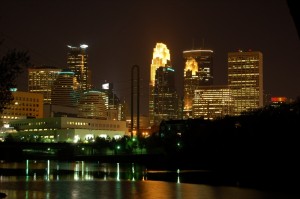Minneapolis
Longfellow | Nokomis | Nokomis-Hale Page Diamond Lake Nokomis East Neighborhood | Southwest | Southwest-Lynnhurst | Southwest-Linden Hills | Uptown | Seward | Bryn Mawr | Near North | Camden | Victory | Willard Hay | Northeast | Downtown Minneapolis | University
 Minneapolis is a city with a rich history. Besides the Dakota people who were here first, the majority of settlers came to Minneapolis in the 1830s because of St. Anthony Falls, the biggest offshoot of the Mississippi River, and the largest water source power in the Midwest. People need water, therefore, people migrate to where the water is. The falls themselves were named by Father Louis Hennepin, who was one of the earliest explorers of Minnesota. Even though early on, the east side of the river was the place to be with Franklin Steele opening the first privately-owned sawmill on that bank, eventually, the west side of the river grew into the place to be.
Minneapolis is a city with a rich history. Besides the Dakota people who were here first, the majority of settlers came to Minneapolis in the 1830s because of St. Anthony Falls, the biggest offshoot of the Mississippi River, and the largest water source power in the Midwest. People need water, therefore, people migrate to where the water is. The falls themselves were named by Father Louis Hennepin, who was one of the earliest explorers of Minnesota. Even though early on, the east side of the river was the place to be with Franklin Steele opening the first privately-owned sawmill on that bank, eventually, the west side of the river grew into the place to be.
Fort Snelling was one of the first important areas of Minneapolis, and much of the early laws revolved around what could and couldn’t be done with military land. For example, one could not build a residence on military land. However, by 1850, Colonel John Stevens finagled his way into 160 acres near the falls—now the site of downtown Minneapolis—which the government gave him as payment of sorts for operating a ferry. From these beginnings, Stevens and others planned the town of Minneapolis, which was put into fruition in 1856. The name itself, originally Minnehapolis, was derived by combining “Minnehaha” meaning waterfalls in Sioux (not laughing waters as commonly believed) and “polis”, Greek for city. The “h” was dropped, giving the current name of the city “Minneapolis” which means “city of waters.”
